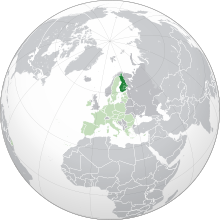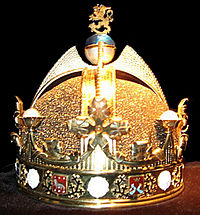
.
.
-‘finland’ is a ‘nordic country’ in ‘northern europe’ bordering…-
the Baltic Sea,
Gulf of Bothnia,
and Gulf of Finland,
between…
Norway to the north,
Sweden to the northwest,
and Russia to the east.
The capital and largest city is Helsinki.
Other major cities are Espoo, Vantaa, Tampere, Oulu and Turku.
Finland’s population is 5.52 million (as of half of 2019),[8] the majority of whom live in the central and south of the country and speak Finnish, a Finnic language from the Uralic language family, unrelated to the Scandinavian languages
Finland is the eighth-largest country in Europe and the most sparsely populated country in the European Union
It is a parliamentary republic of 311 municipalities,[10] and one autonomous region, the Åland Islands. Over 1.4 million people live in the Greater Helsinki metropolitan area, which produces one third of the country’s GDP.
Finland was inhabited when the last ice age ended, approximately 9000 BCE.[11] Comb Ceramic culture introduced pottery 5200 BCE and Corded Ware culture coincided with the start of agriculture between 3000 and 2500 BCE. The Bronze Age and Iron Age were characterised by extensive contacts with other cultures in the Fennoscandian and Baltic regions. At the time Finland had three main cultural areas – Southwest Finland, Tavastia and Karelia.[12] From the late 13th century, Finland gradually became an integral part of Sweden through the Northern Crusades and the Swedish part-colonisation of coastal Finland, a legacy reflected in the prevalence of the Swedish language and its official status. In 1809, Finland was incorporated into the Russian Empire as the autonomous Grand Duchy of Finland. In 1906, Finland became the first European state to grant all adult citizens the right to vote, and the first in the world to give all adult citizens the right to run for public office.[13][14]
Following the 1917 Russian Revolution, Finland declared itself independent. In 1918, the fledgling state was divided by civil war, with the Bolshevik-leaning Red Guard, supported by Soviet Russia, fighting the White Guard, supported by the German Empire. After a brief attempt to establish a kingdom, the country became a republic. In World War II, Finland lost parts of Karelia, Salla, Kuusamo and Petsamo to the Soviet Union.
Finland joined the United Nations in 1955 and adopted an official policy of neutrality. The Finno-Soviet Treaty of 1948 gave the Soviet Union some leverage in Finnish domestic politics during the Cold War. Finland joined the OECD in 1969, the NATO Partnership for Peace in 1994,[15] the European Union in 1995, the Euro-Atlantic Partnership Council in 1997,[15] and the Eurozone at its inception in 1999.
Finland was a relative latecomer to industrialisation, remaining a largely agrarian country until the 1950s. After World War II, the war reparations demanded by the Soviet Union forced Finland to industrialise. The country rapidly developed an advanced economy while building an extensive welfare state based on the Nordic model, resulting in widespread prosperity and one of the highest per capita incomes in the world.[16] Finland is a top performer in numerous metrics of national performance, including education, economic competitiveness, civil liberties, quality of life, and human development.[17][18][19][20] In 2015, Finland was ranked first in the World Human Capital[21] and the Press Freedom Index and as the most stable country in the world during 2011–2016 in the Fragile States Index,[22] and second in the Global Gender Gap Report.[23]
It also ranked first on the World Happiness Report report for 2018 and 2019.[24]
(a large majority of ‘finns’ are members of the ‘evangelical lutheran church‘)
(‘freedom of religion’ is guaranteed under the ‘finnish constitution’)
Kemi (Northern Sami: Giepma) is a town and municipality of Finland. It is located very near the city of Tornio. It was founded in 1869 by decree of Russian Emperor Alexander II because of its proximity to a deep water harbour.

The Crown designed for theKing of Finland
Kemi is situated by the Bothnian Bay, at the mouth of river Kemijoki, and it is part of Lapland region. The town has a population of 21,807 (30 June 2015)[2] and covers an area of 747.44 square kilometres (288.59 sq mi) of which 652.1 km2(251.8 sq mi) is water.[1] The population density is 228.73 inhabitants per square kilometre (592.4/sq mi).
The main economic activity in Kemi is centred on two large paper and woodpulp mills and on the only chromium mine in Europe (which supplies the Outokumpu ferrochrome plant in Tornio). A polytechnic university of applied sciences is also situated in Kemi.
Kemi also has a claim to fame as the home of the world’s largest snow castle (reconstructed every year to a different design). The snowcastle is usually located at the inner harbour of Kemi.
A model of The Crown of Finland (the original was never made for the King of Finland) is kept in the town’s gemstone gallery. It also houses replicas of the Imperial State Crown of Great Britain, the Sceptre of the Czar of Russia, the Orbs of Denmark and the diamond necklace of Marie Antoinette, among other items.
(‘kemi’ is also the hometown of the power metal band ‘sonata arctica’)
.



.
(Finnish: Suomi [ˈsuo̯mi] (listen); Swedish: Finland [¹fɪnland] (listen), Finland Swedish: [ˈfinlɑnd]), officially the Republic of Finland (Finnish: Suomen tasavalta, Swedish: Republiken Finland (listen to all)),[note 1]
.
.
*👨🔬🕵️♀️🙇♀️*SKETCHES*🙇♂️👩🔬🕵️♂️*
.
.
.
.
.
💕💝💖💓🖤💙🖤💙🖤💙🖤❤️💚💛🧡❣️💞💔💘❣️🧡💛💚❤️🖤💜🖤💙🖤💙🖤💗💖💝💘
.
.
*🌈✨ *TABLE OF CONTENTS* ✨🌷*
.
.
🔥🔥🔥🔥🔥🔥*we won the war* 🔥🔥🔥🔥🔥🔥
